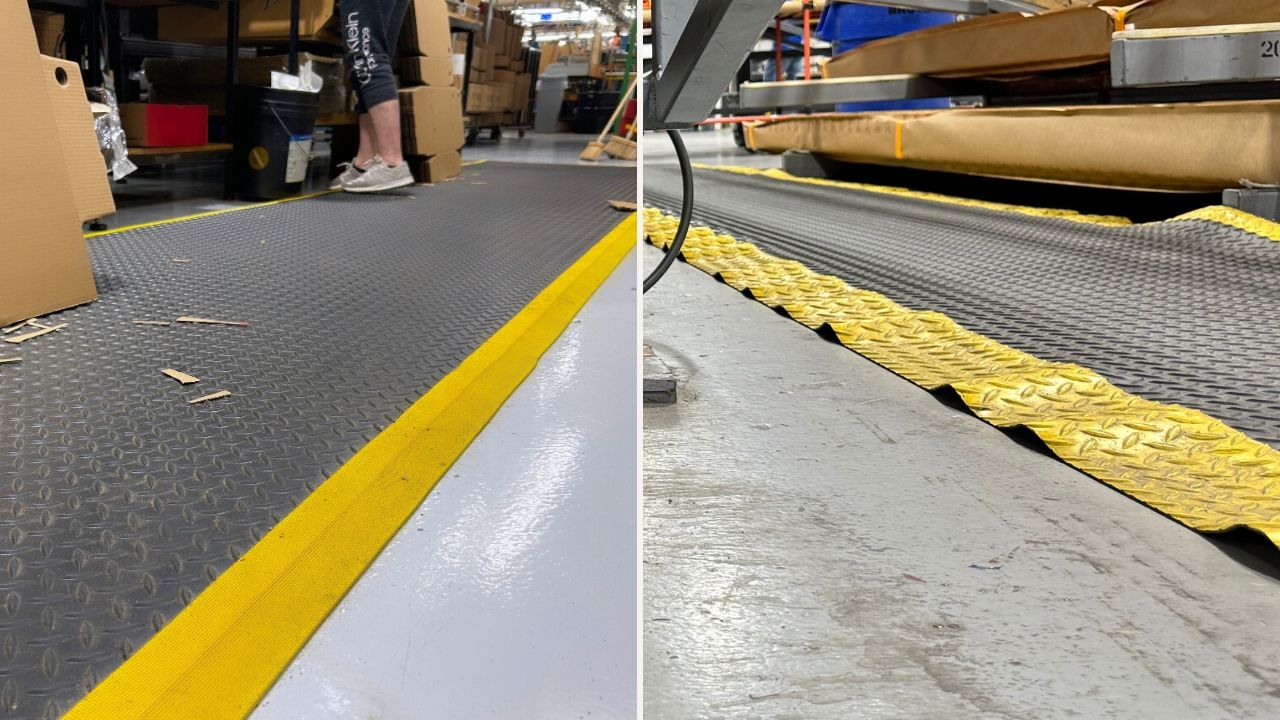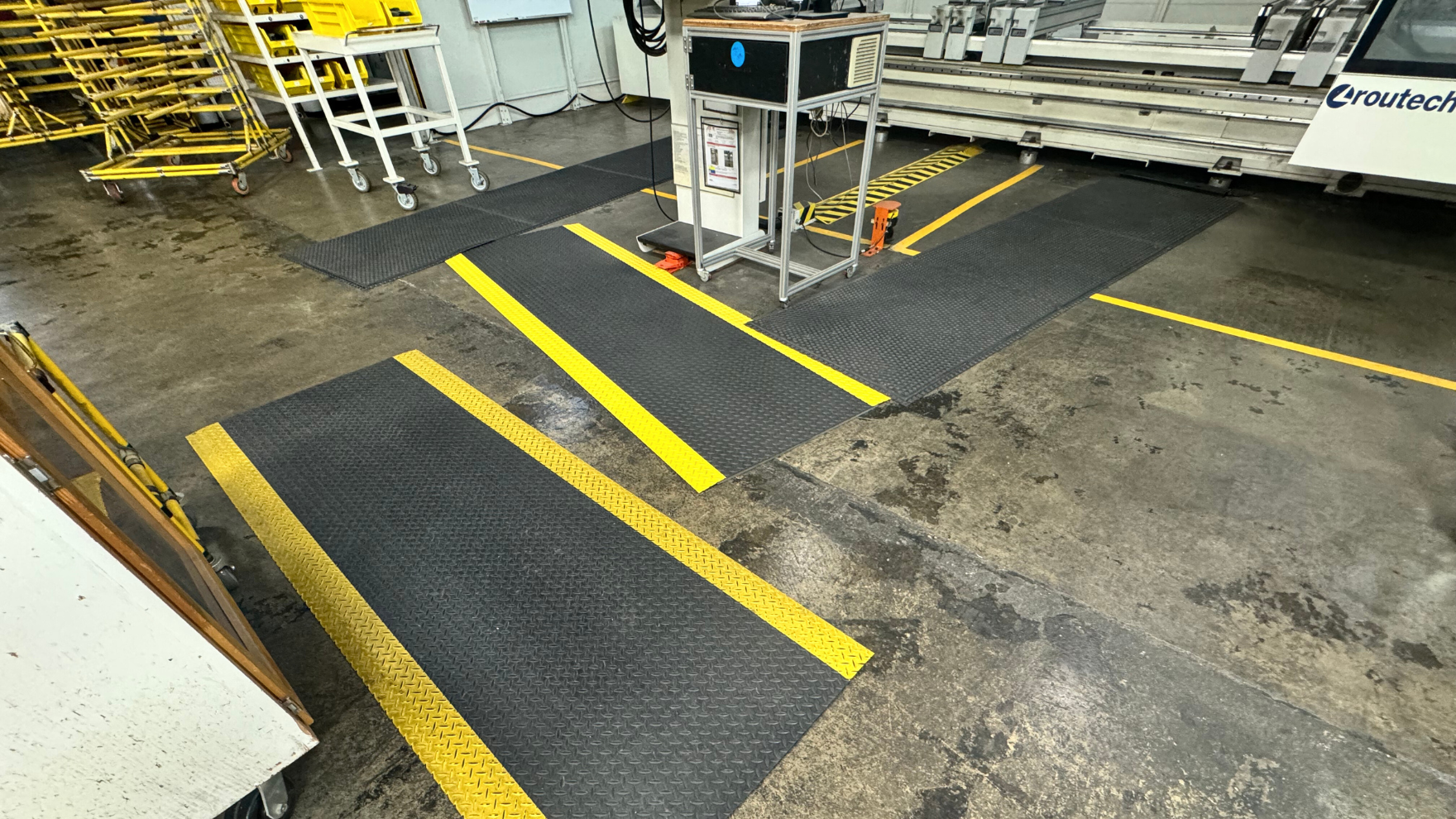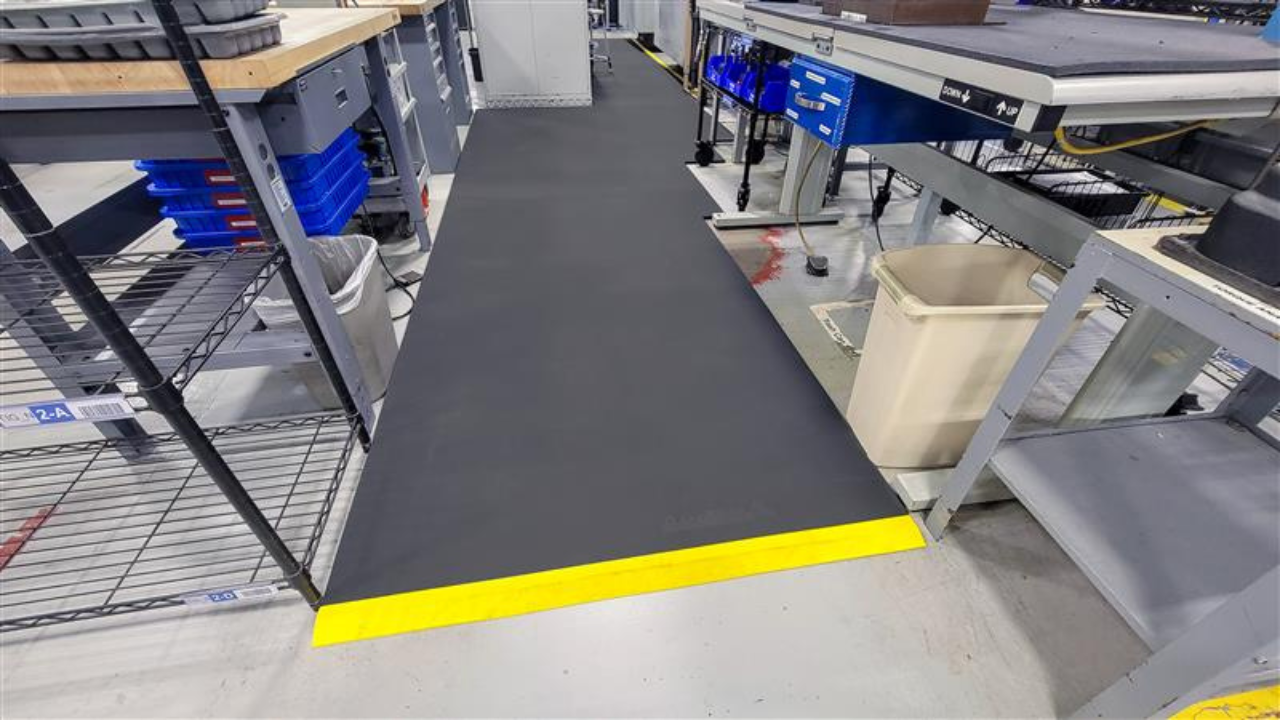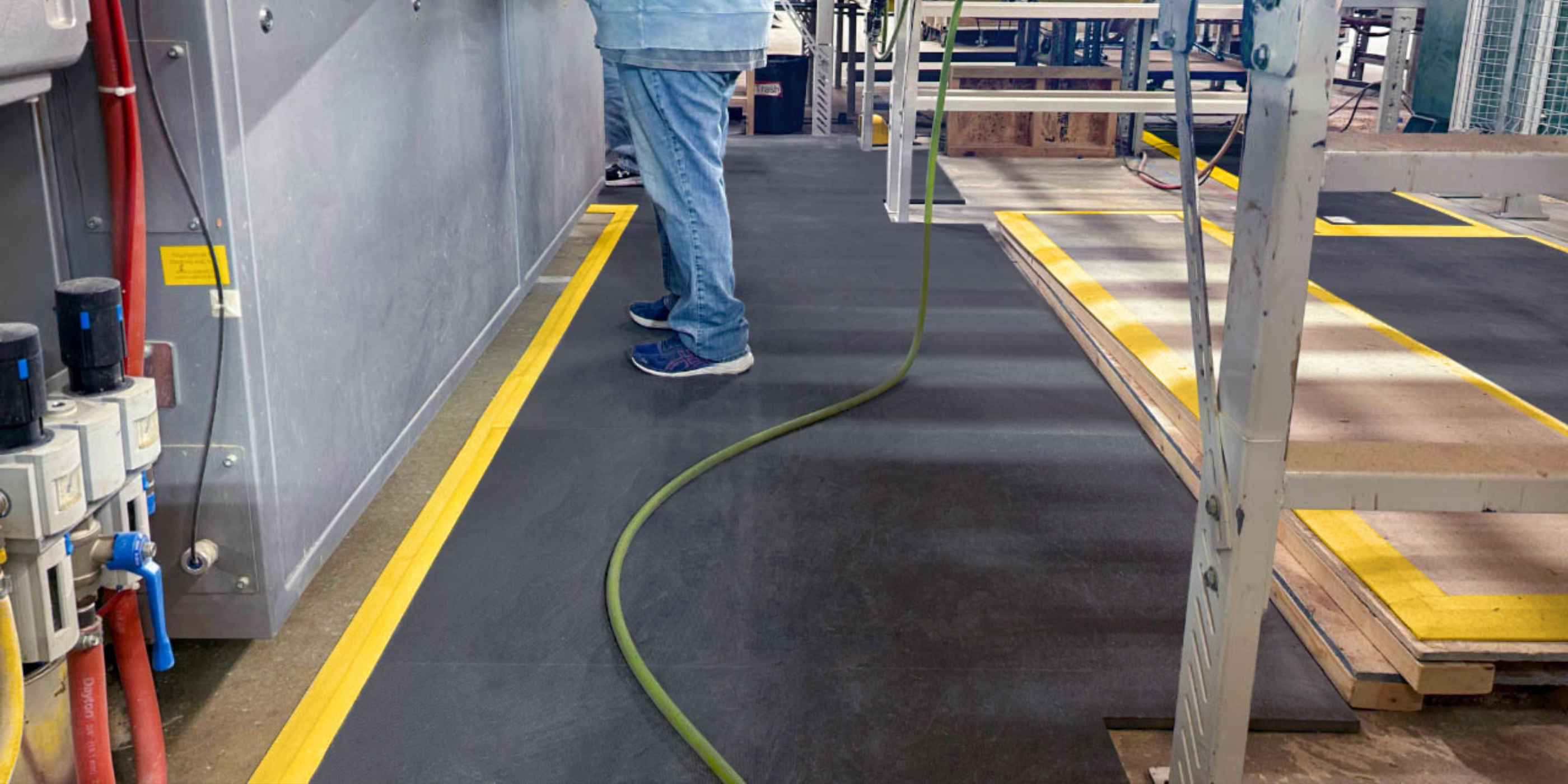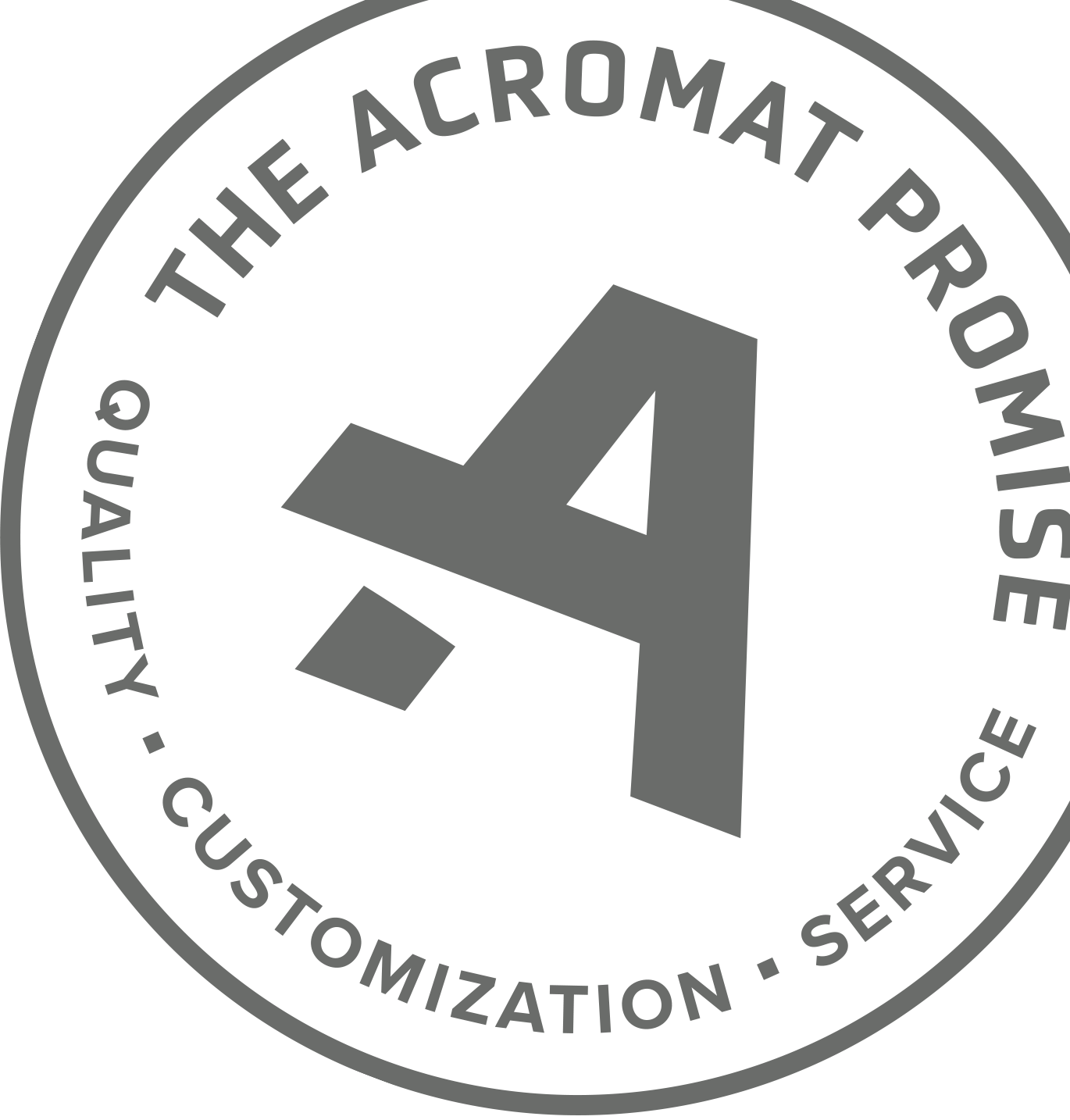Slips, trips, and falls are the leading cause of injury in manufacturing. One of the most common trip hazards in the industry? Anti-fatigue mats that curl upwards.
Here are 6 reasons the edges of your anti-fatigue mats curl, including steps you can take to prevent curling from happening.
Visit our updated article on the topic of curling, including before/after visuals, action steps, first-hand case studies: 5 Ways to Prevent Your Anti-Fatigue Mats From Curling
1. The anti-fatigue pad is buckling
As bacon cooks on a fryer, the lean meat and fat react differently. This causes the strips to buckle and curl. Coined “the bacon effect” by an AcroMat client, this same effect happens to diamond-plate mats made using the “waterfall” design.
 Left: "Waterfall" diamond mat in a coffee manufacturing facility. Right: AcroMat NitriTuf Diamond mat; exclusive design and materials guarantees the mat will not compress or curl over time. Put a free sample to the test.
Left: "Waterfall" diamond mat in a coffee manufacturing facility. Right: AcroMat NitriTuf Diamond mat; exclusive design and materials guarantees the mat will not compress or curl over time. Put a free sample to the test.
Diamond-plate mats consist of two pieces – a foam pad, which provides anti-fatigue cushioning, and the diamond-plate material which is laid over top. The two pieces are glued together to form a diamond-plate mat. Over time, the pad in a water fall design shrinks inward, lifting up the edges of the mat.
With the cut-and-bond design we use at AcroMat, the right photo above, the anti-fatigue pad and diamond surface extend collectively to the edge of the mat (no overhang like the waterfall design). The 100% nitrile borders, which are chemical resistant and incapable of absorbing liquids, are then bonded to the mat.
This design creates a more seamless and intentional transition to the floor, one that keeps the mat flat. This design actually allows us to guarantee the borders will never curl.
Action Step:
Look closely at how the edges of your anti-fatigue mats are designed, and ask your supplier if there's a risk of curling based on your particular environment. Changing temperatures, oil, grease and chemical spills, and particle accumulation can cause lower-quality foam pads and mats to shrink, buckle, and curl.
Related: AcroMat Mats Proven to Never Curl After Accelerated Aging Test
2. Your mats aren't impervious to liquids and chemicals
PVC foam is the most common anti-fatigue mat material. PVC foam/nitrile blends aren't far behind. While versatile and inexpensive, PVC foam is not impervious to liquids. In heavy industrial settings with oil, grease or chemical spills, these products will seep into your mats causing them to buckle, crack and bloat. In turn, this lifts the edges of your mats off the floor.
Action Step:
Pure 100% nitrile is impervious to liquids and chemicals. It is physically incapable of absorbing liquids. Look for anti-fatigue mats made from pure nitrile if you have a wet/oily environment, or at the very least mats with a warranty that guarantees they will no absorb, bloat, crack, or curl from liquids and particles.
 Left: PVC foam mats after 2 years; erosion, curling, and sliding present. Right: 100% nitrile after 5+ years; fully intact, unaffected by constant spills and splashes.
Left: PVC foam mats after 2 years; erosion, curling, and sliding present. Right: 100% nitrile after 5+ years; fully intact, unaffected by constant spills and splashes.
3. You have constant cart traffic
Constantly rolling carts on and off your mats can wear on the edges. Over time, this can chip away at the fabric and cause the edges to curl upwards.
Few second clip showing cart seamlessly rolling over AcroMat ADA-compliant, 20-degree yellow borders.
Action Step:
Before you invest in anti-fatigue mats, ask the following:
Q: What are the angles of your beveled edges?
Q: Are they designed specifically to accommodate heavy cart traffic?
AcroMat mats come standard with 30-degree bevels. Thirty degrees is sound for areas with clean lines of sight and primarily foot traffic. We also offer ADA-compliant, 20-degree yellow border option that can be custom added to any mat. Twenty degrees better supports areas with heavy cart traffic and teams that need to take extra precaution regarding tripping and slipping.
 AcroMat 100-1 Series mat designed with 20-degree yellow borders to accommodate cart traffic and add precaution in a fast-paced environment.
AcroMat 100-1 Series mat designed with 20-degree yellow borders to accommodate cart traffic and add precaution in a fast-paced environment.
4. The edges are being kicked daily
Mats that are not designed to fit the work area lead to constant on/off stepping. Combined with materials and edges that are not designed for the environment, this leads to operators kicking and tripping over the borders day after day.
 Constantly kicking mats due to difficult on/off transitions can curl mat edges upward. This quickly ages your mats and is a clear safety hazard.
Constantly kicking mats due to difficult on/off transitions can curl mat edges upward. This quickly ages your mats and is a clear safety hazard.
The EHS manager over the facility below had an employee trip and break their wrist due to rectangular mats piled next to each other and inconsistent borders. Hear the full story, including how they eliminated trip hazards by swapping out 5+ rectangular mats for a single custom mat designed to fit.
5. Your mats are pushing up against equipment
Mats that push up against table legs, walls, and machinery can bunch and roll. Leaving them up against equipment for long periods of time can make the curling permanent, creating safety hazards and limiting the lifespan of your mats.
Action Step:
During mat installation, make sure they are correctly placed. Check them regularly. Further, make sure you have a mat material that will not slide around.
 Left: Poorly placed, stacked rectangular mats that don't fit and easily slide around. Right: One-piece custom 100-1 Series mat that fits like a glove up against machinery; no threat of sliding or curling.
Left: Poorly placed, stacked rectangular mats that don't fit and easily slide around. Right: One-piece custom 100-1 Series mat that fits like a glove up against machinery; no threat of sliding or curling.
6. Your mats have aged out
One of the clearest signs your mats have reached the end of the road are borders that have broken apart, ripped, and curled. Often, curling is a result of 1-5 above. Other times it may simply be because your mats are long past their useful life.
Action step:
Review the life expectancy of your anti-fatigue mats. Also, check the warranty! If you have premium ergo mats in your facility, they should have an ironclad warranty against curling. If they don't, it may be time to look elsewhere.
Main Takeaway
Material and design. While there are many reasons mats curl, it primarily comes down to these two key features. Make sure you have the right materials for your particular environment (durability), and the right design to prevent these materials from curling upwards over time.
Before your next investment, ask your provider 3 design questions:
- How do your mat materials prevent curling borders?
- How does the mat design prevent curling?
- Does the warranty guarantee this?
Simple questions. Should be straightforward answers.
